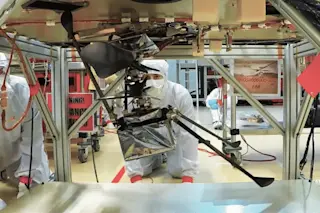If you're like most people, you've dreamed of flying (studies show that more than half of us have done it). If you're curious about the universe, you've probably also dreamed about visiting other planets. And if you're willing to wait about nine months, you are in luck — because after that, you won't have to dream anymore.
Ladies and gentlemen, NASA is about to go flying on Mars.
The Perseverance rover, scheduled to land on February 18, 2021, is carrying a grapefruit-sized helicopter named Ingenuity strapped to its belly. Assuming all goes well with the touchdown, Perseverance will settle into its new home for about two months. Then it will release a small debris shield, fire a pyrotechnic cable-cutter, unleash a spring-loaded arm and set the little Ingenuity flyer free.
After the rover has rolled a safe distance away, Ingenuity will soak up sunlight to charge its six lithium-ion batteries, ...














